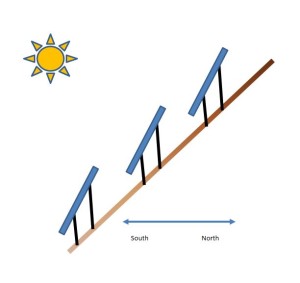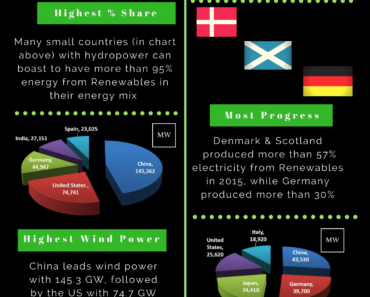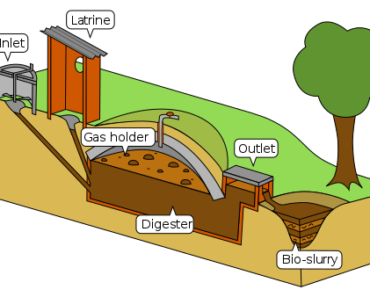Contents
Solar power holds tremendous potential. It is the most abundant form of renewable energy. It is known and commonly cited that if solar panels were to cover an area smaller than the size of Wales than the generated electricity would be enough to power whole of Europe. And this fact has been the inspiration of Desertec project that seeks to electrify both Europe and Africa by tapping the plentiful solar energy in the Sahara Desert.
Large scale solar power plants are of different types and can be based on completely different technologies. Solar parks are normally power stations that involve large arrays of photo –voltaic (PV) modules. The other types are solar thermal power plants in which the solar heat by way of thermodynamic power cycle is used to generate electricity. These solar thermal plants can have either power tower or solar trough technology. A slightly different type of solar thermal technology is called the Solar-Power Stirling Engines. This technology in fact has shown the highest efficiency among all solar technologies (28%).
There are some common requirements for a Solar PV and Solar Thermal power plants . These along with other more specific requirements for solar power plant planning are listed below.
Solar Resource/ Arid Zones
Solar thermal power plants work only in Arid regions. They can be installed in areas where annual precipitation is low and the direct component of solar radiation is much higher than annual diffuse radiation.
Contrary to the popular belief, they should not be installed right on the equator belt. The region near the equator falls in the ITCZ (Inter-tropical convergence zone) . It is a region where warm air rises and precipitation occurs. When looking at world map, one can notice the presence of rain forests in the ITCZ or in the vicinity of the equator. Thus Solar thermal plants must be situated not just on the equator but either above or below the ITCZ i.e. in the STHP (Subtropic high pressure region).
On the other hand, Solar PV farms do not require direct solar radiation to work. They can generate electricity even in the presence of a thick cloud cover, as long as there is light. The power generated in cloudy conditions may be a fraction of the peak power but nonetheless can be significant depending upon the size of the plant. Owing to this characteristic, Solar PV farms have been installed in many northerly (Sub Polar) regions. It should also be noted that because the internal resistance in circuits doubles with every 10 °C rise in temperature, solar PV don’t appreciate heat. Their efficiency degrades with higher temperatures. Installation of Solar PV in a very hot desert therefore would need an active cooling system to maintain performance. Whereas in northern regions, low air temperature is enough to whisk away the build-up of heat and no cooling jackets are required.
Proximity to Power lines
Solar power plant must be in close proximity to a high power transmission line. This allows the power generated to be fed to the grid with minimal losses. Ideally it should be situated in the vicinity of a population center so that electricity is locally consumed and the transmission losses are minimized. A good example of this is Andasol power plant (150 MW parabolic trough) near Gaudix, Spain and PS10 and PS20 (power towers) located near Valencia, Spain. Another example worth mentioning is Solar PV plant powering up Nellis Air force base in Nevada, USA. This power plant in the Mojave desert produces electricity cheaper than what is available from the grid. Solar power has also been used for off-grid applications.
Terrain
In the northern hemisphere, site that may have shading obstacles towards the south, should be avoided. Trees and hills can produce shadows that can limit the solar gain particularly when the sun is low (such as in winters).
For a solar thermal power plant a tracking system is compulsory. For a solar PV plant, tracking is not a requirement but improves the overall gain by as high as 30%. If tracking system is installed on the PV arrays than flat terrain should be preferred.
If tracking system is not installed than a hilly / sloped terrain can prove beneficial provided that the incline slope runs from the south to the north direction. This allows the sun to be in the view of every collector most time during the day and prevents shade of one collector on the other. It has been suggested that many abandoned open-pit mines can be used as Solar PV farms.
Water
Solar PV farms do not use power but because solar thermal power plants run on a Rankine cycle, they can use either water or heating fluid as a energy transfer medium. Part of that water may be lost as steam in an open loop system. Furthermore a cooling source is required to condense the water coming out of the turbine. If cooling towers are employed than again some water is lost in evaporation. The places where most solar energy is present also turn out to be the driest. Thus access to a water source should be considered for Solar Thermal power plants.
Site Accessibility
Just as the presence of transmission lines reduces the transmission costs drastically likewise Site accessibility through roads is an important factor. Having an infrastructure in place close to the site increases the feasibility of solar project. Cities that are built in arid regions and rely on underground aquifers such as Las Vegas and Kufra (Libya) are best locations for Solar power projects. Similarly Al Masdar project in Abu Dhabi has been a huge success.
Sand Storms/ Dust
The location of solar power plants in arid regions also require maintenance. In case of a sand storm or Ghiblii, the accumulation of dust on the PV panels, Heliostats or the Fresnel lenses can stop electricity production completely. Therefore regions that are semi-arid would be in many cases more desirable for plant sites. At many plants people are employed to routinely clean the reflectors and collectors. Robots and automated systems for these tasks have also been used but increase the running costs.
Conclusions
Solar power plant, in particular thermal power plants are located in Arid zones which are uninhabited. Although they require a huge area but are located in regions where ecological impact is next to none. While wind farms are visible from a long distance, can have noise issues and result in bird strikes, Solar power plants are free from these problems. Nonetheless care should be exercised in selecting the plant site. As noted abundance of Solar insolation is not the only factor to be accounted in solar power plant planning. Presence of transport and electricity infrastructure is vital and so is the presence of a water source in case of thermal power plants.







